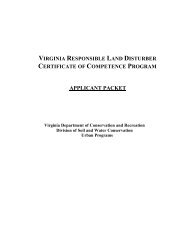Dameron Marsh NAP self-guided field trip guide - Virginia ...
Dameron Marsh NAP self-guided field trip guide - Virginia ...
Dameron Marsh NAP self-guided field trip guide - Virginia ...
Create successful ePaper yourself
Turn your PDF publications into a flip-book with our unique Google optimized e-Paper software.
Stop 6...<br />
• Winged sumac (Rhus copallina), a shrub or small tree typical of advancing old <strong>field</strong> succession<br />
is found along this stretch of the trail. Its fruit in the fall is a large drooping cluster<br />
of tiny seedheads starting out reddish/rusty and turning brown. They often persist on the<br />
shrub in the fall after the leaves have fallen. The ‘wings’ in the name refer to narrow winglike<br />
“leaves” along the stem of the plant in between the stems of the compound leaves..The<br />
berries were of Winged Sumac were used to make a medicine for stomach pain and the<br />
pulp of the stalk was used as a dye. I have heard that you can make a tangy leomade-like<br />
drink out of the berries- .<br />
Stop 7...<br />
• This observation deck was completed in 2002 after just a few months of hard work from out Operations<br />
Steward and a few good volunteers. One volunteer (Bob Healy) generously gave over 200 hours of his time<br />
and energy to the completion of the deck.<br />
• Stress that minimizing disturbance is the best way to keep out the invasive grass Phragmites. The area that<br />
you are looking at here was an area that we parked vehicles and staged equipment during deck construction.<br />
There was very little phrag in this area before construction. There was some—but not much. This is a good<br />
lesson on how quickly and completely this plant can take over.<br />
• This area was sprayed in 2004. Plans to control this grass in 2004 were postponed in 2003 due to the fact<br />
that salt spray from Isabel caused this plant to die and go dormant before we could spray it. If plants are not<br />
actively growing the chemical can not be delivered to the roots. Getting the chemical into the roots of this<br />
plant is a key to successful control.<br />
• There is a large patch of <strong>Marsh</strong> mallow to the left at the bottom of the boardwalk. This will be in seed<br />
now. <strong>Marsh</strong> mallow (Hibiscus moscheutos) also called Rose mallow, is the huge showy plant of the marsh.<br />
Stems can reach 6 feet high and the flowers are 4-8 inches across. Generally white, but sometimes pink,<br />
these flowers always have a red center.<br />
• Near the end of the boardwalk is a wax myrtle that has fruit on it—birds LOVE these berries.<br />
Boardwalk construction<br />
October 2002<br />
<strong>Marsh</strong> mallow<br />
Hibiscus moscheutos<br />
Wax myrtle berries<br />
Morella cerifera
















